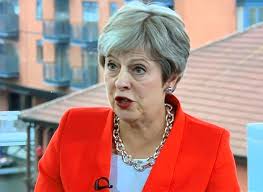My deal, no deal or no Brexit, UK PM May says after winning ministers’ backing

British Prime Minister Theresa May won the backing of her senior ministers for a draft European Union divorce deal on Wednesday, freeing her to tackle the much more perilous struggle of getting parliament to approve the agreement.
More than two years after the United Kingdom voted in a referendum to leave the EU, May told reporters outside her Downing Street residence that she had won over her divided cabinet, which includes some senior Brexiteers.
“The collective decision of cabinet was that the government should agree the draft withdrawal agreement and the outline political declaration,” she said, after a five-hour meeting.
Speaking over protesters shouting anti-Brexit slogans from the end of the street, she said the deal, 585 pages long, was the best that could be negotiated.
“When you strip away the detail, the choice before us was clear: this deal, which delivers on the vote of the referendum, which brings back control of our money laws and borders, ends free movement, protects jobs security and our Union; or leave with no deal; or no Brexit at all,” she said.
It was not immediately clear whether any ministers would resign over the deal, which May hopes will satisfy both Brexit voters and EU supporters by ensuring close ties with the bloc after Britain leaves on March 29.
But the weakest British leader in a generation now faces the ordeal of trying to push her deal through a vote in parliament, where opponents lined up to castigate the agreement, even before reading it.
Brexit will pitch the world’s fifth largest economy into the unknown. Many fear it will divide the West as it grapples with both the unconventional U.S. presidency of Donald Trump and growing assertiveness from Russia and China.
Supporters of Brexit admit there may be some short-term pain for Britia’s $ 2.9 trillion economy, but say that, in the long term, it will prosper when cut free from the EU – which they cast as a failing German-dominated experiment in European integration.
PARLIAMENT VOTE
A summit of EU leaders is likely be held on Nov. 25, Irish Prime Minister Leo Varadkar said. May gave no date for a vote in parliament but she will need the votes of about 320 of the 650 lawmakers. It is unclear whether she has the numbers.
“I know there will be difficult days ahead and this is a decision that will come under intense scrutiny, and that is entirely as it should be,” May said.
During the cabinet meeting, British journalists said anger among Brexit-supporting Conservative lawmakers was so high that they might call for a vote of no confidence in her leadership. There was no confirmation.
The ultimate outcome for the United Kingdom remains uncertain: scenarios range from a calm divorce to rejection of May’s deal, potentially sinking her premiership and leaving the bloc with no agreement, or another referendum.
May, an initial opponent of Brexit who won the top job in the turmoil following the referendum, has staked her future on a deal that she hopes will solve the Brexit riddle: leaving the EU while preserving the closest possible ties.
But she has satisfied few. Brexit supporters in May’s party, which has been riven by a schism over Europe for three decades, said she had surrendered to the EU and that they would vote down the deal.
Many opponents of Brexit are also upset as they fear Britain will be subject to the EU’s rules while getting none of the benefits of membership. Some want another referendum.
Opposition Labour Party leader Jeremy Corbyn called it a “botched deal”.
The Northern Irish Democratic Unionist Party (DUP) which props up May’s government, said it would not back any deal that treated the British province differently from the rest of the United Kingdom.
“If she decides to go against all of that, then there will be consequences,” DUP leader Arlene Foster said, though she refrained from explicitly opposing the deal. She is due to meet May on Wednesday night.
IRELAND
The difficult issue in the talks was the Northern Irish ‘backstop’, an insurance policy to avoid a return to controls between the British province and EU-member Ireland which could threaten the 1998 peace accord which ended 30 years of violence.
The draft accord envisages a July 2020 decision on what would have to be done to safeguard an open Irish border after the post-Brexit transition runs its course if a new trade deal is not in place.
If not, Britain would have to extend the transition period once beyond December 2020, possibly until the end of 2021, or go into a customs arrangement that would cover all of the United Kingdom, but in which Northern Ireland would be aligned more closely with the EU’s customs rules and production standards.
A UK government explanatory note on the deal said this meant that “there will be an option to avoid the backstop, even in the event that our future relationship is not complete and a temporary bridge is required”.
“In those circumstances, whether it would be preferable for the backstop to come into effect for a temporary period, or to request a temporary extension of the implementation period, will be a sovereign choice for the UK Government.”
It is unclear if that will pass muster in parliament.
